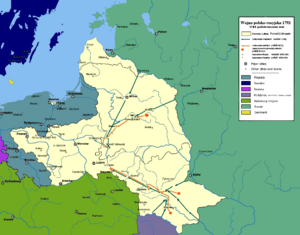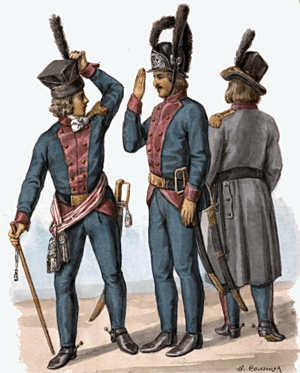Polish–Russian War of 1792 facts for kids
Quick facts for kids Polish–Russian War of 1792 |
|||||||||
|---|---|---|---|---|---|---|---|---|---|
| Part of the Polish–Russian Wars | |||||||||
 Polish–Russian War of 1792 |
|||||||||
|
|||||||||
| Belligerents | |||||||||
|
|||||||||
| Commanders and leaders | |||||||||
| Strength | |||||||||
| 98,000 men | 70,000 men | ||||||||
| Casualties and losses | |||||||||
|
Around 2,000 according to Russian sources Above 7,000 according to Polish sources |
Around 3,000 | ||||||||
The Polish–Russian War of 1792 was a conflict between the Polish–Lithuanian Commonwealth and the Russian Empire. It is also known as the War of the Second Partition. In Poland, it was called the "War in Defence of the Constitution."
The war happened in two main areas: in Lithuania (north) and in what is now Ukraine (south). Polish forces often had to retreat because the Russian army was much larger. However, the Polish army in the south fought bravely. This was thanks to skilled leaders like Prince Józef Poniatowski and Tadeusz Kościuszko.
During the war, several battles took place. The Polish forces won a notable victory at the Battle of Zieleńce on June 18. After this battle, Poland created its highest military award, the Virtuti Militari. The war ended when the Polish King, Stanisław August Poniatowski, decided to seek peace. He agreed to join a group of Polish nobles who supported Russia, called the Targowica Confederation.
Contents
Why the War Started
Poland's Challenges
By the early 1700s, powerful noble families, called magnates, controlled the Polish-Lithuanian Commonwealth. They made sure no changes happened that would reduce their power. One big problem was the liberum veto rule. This rule allowed any single member of the parliament (called the Sejm) to stop all new laws. This made the government very weak for over 100 years.
Neighboring countries liked Poland being weak. They did not want a strong, democratic Poland next door. Poland's army was very small, with only about 16,000 soldiers. This made it easy for powerful neighbors like Russia and Prussia to interfere in Poland's affairs.
Attempts to Make Poland Stronger
A chance to make Poland stronger came during the "Great Sejm" (parliament) from 1788 to 1792. At this time, Poland's neighbors were busy fighting other wars. Russia was fighting against the Ottoman Empire and Sweden. This meant they couldn't easily stop Poland from making changes.
Poland also formed a new alliance with Prussia. This seemed to offer protection from Russia. On May 3, 1791, Poland adopted a new constitution. Most people supported it. This constitution aimed to make Poland's government much stronger.
The New Constitution and Its Enemies
When Russia's wars ended, Tsarina Catherine was very angry about Poland's new constitution. Russia saw Poland as a country it controlled. The new constitution threatened Russia's influence. Prussia also opposed the constitution. Its leaders worried that a stronger Poland might try to reclaim lands Prussia had taken earlier.
Not everyone in Poland liked the new constitution either. Some powerful magnates, who had opposed the constitution from the start, asked Tsarina Catherine for help. These nobles formed the Targowica Confederation. They claimed the constitution was a "revolution" that took away their traditional freedoms. They asked Tsarina Catherine, whom they called a "fair empress," to send her army to restore their old privileges.
On May 18, 1792, Russia's ambassador told Poland that Russia was declaring war. Russian armies entered Poland and Lithuania on the same day, starting the conflict.
Who Fought in the War?
The Russian Army
The Russian army had nearly 98,000 soldiers. It was led by generals like Mikhail Krechetnikov and Mikhail Kakhovsky. The Russian soldiers also had more experience in battles. Their plan was to attack Poland from both the south (through Ukraine) and the north (through Lithuania). Both forces aimed to meet near the Polish capital, Warsaw. Russia had good information about the Polish army's positions and strength.
The Polish Army
King Stanisław August Poniatowski was the official commander of the Polish forces. But he gave control to his nephew, Prince Józef Poniatowski. In theory, Poland had about 48,000 soldiers in the main Polish army and about half that number in the Lithuanian army. However, in reality, Poland only had about 37,000 soldiers ready to fight. The army was still being organized and lacked equipment and experienced officers.
In the south (Ukraine), Prince Poniatowski led about 17,000 to 24,000 Polish soldiers. He was supported by Tadeusz Kościuszko. They faced a much larger Russian army of about 64,000 men. The Targowica Confederates, the Polish nobles who sided with Russia, did not have many soldiers. Even the Russians saw them as not very useful in battle.
In the north (Lithuania), the Lithuanian army had about 15,000 soldiers. Their commander, Duke Louis of Württemberg, did not prepare his troops for war and later betrayed the Polish cause. The Russian army in this area had about 33,700 to 38,000 soldiers.
About 8,000 more Polish soldiers were kept in Warsaw as a reserve force.
Key Battles and Events
Fighting in the South (Ukraine)
The first Russian forces crossed into Ukraine on May 18, 1792. They met more resistance than they expected because Prince Poniatowski and Kościuszko were leading the Polish forces there. The Polish army was too small to fight the four large Russian columns. They began to retreat slowly towards the Southern Bug River. Kościuszko commanded the rear guard, protecting the retreating army.
On June 14, a Polish unit was defeated at the Battle of Boruszkowce. But on June 18, the Poles, led by Prince Poniatowski, won a victory at the Battle of Zieleńce. King Poniatowski celebrated this win. He sent the new Virtuti Militari medals to the leaders and soldiers.
Despite this victory, the Russian forces continued to advance. The Polish army retreated in good order, avoiding being completely destroyed. In early July, near Dubno, a Polish magnate named Michał Lubomirski betrayed them. He was supposed to bring supplies but instead joined the Russians or hid the supplies.
By about a month after the invasion, most Polish forces had left Ukraine. On July 7, Kościuszko's forces fought a delaying battle at Volodymyr-Volynskyi (Battle of Włodzimierz). On July 18, Kościuszko's units fought the Battle of Dubienka. With about 5,300 soldiers, Kościuszko held off an attack by 25,000 Russians. The Poles had to retreat from the Bug River line, but they were not defeated.
Fighting in the North (Lithuania)
In Lithuania, the Russians crossed the border on May 22. Poland's ally, Prussia, broke its alliance. The Prussian commander of the Lithuanian army, Duke Württemberg, refused to fight. He pretended to be sick and gave confusing orders.
Because of this, the Lithuanian army did little to stop the Russians. They kept retreating. Minsk was abandoned on May 31. After a new commander, General Józef Judycki, took over on June 4, the army tried to fight. But the Russians defeated Judycki at the Battle of Mir on June 11.
The Russians continued to advance. They took Wilno on June 14, Nieśwież on June 19, and Kaunas on June 20. Judycki was replaced by Michał Zabiełło on June 23. The Polish army in the north retreated towards Warsaw. They took defensive positions near Brest. On July 24, the Poles won a small victory near Krzemień-Wieś. This was their first important win on the northern front.
How the War Ended
Prince Poniatowski and Kościuszko believed they could still win the war. They planned to combine their forces to defeat the Russian armies. However, King Poniatowski decided to ask for a ceasefire. Tsarina Catherine demanded that the King join the pro-Russian Targowica Confederation. The King agreed around July 22–23. This decision forced Prince Poniatowski to stop fighting.
The last battle of the war happened on July 26 at Markuszów. Polish cavalry, led by Poniatowski, pushed back an enemy attack.
At the time the King decided to stop fighting, the Polish army was still in good shape. They had not suffered any major defeats and had enough supplies. King Poniatowski thought that Russia's larger army meant defeat was coming anyway. He hoped to get a better deal through talking with the Russians. Many historians still debate if this was the right choice.
Many Polish soldiers and leaders were unhappy with the ceasefire. Kościuszko, Prince Poniatowski, and others resigned from the army. Prince Poniatowski even thought about rebelling against his uncle, the King. But in the end, he decided not to continue fighting against the King's wishes.
What Happened After the War?
Most Polish historians agree that stopping the war was a mistake. From a military view, the Poles could have defended the Vistula River line and tired out the Russian army. From a political view, showing a willingness to fight might have made the powerful neighbors think twice about taking Polish land.
King Poniatowski's hopes for a good peace deal were soon crushed. With new members of parliament bribed or scared by Russian troops, a new parliament session took place in 1793. This parliament, called the Grodno Sejm, was forced to agree to the Second Partition. This meant Russia and Prussia took huge parts of Poland's land. Poland's population was cut to one-third of what it was before. Russian troops controlled the remaining small Polish state.
This outcome surprised most of the Targowica Confederates. They only wanted to bring back the old system where powerful nobles had more control. They did not expect Poland to lose so much land. The last attempt to make Poland strong again was the Kościuszko Uprising in 1794. This uprising failed. It led to the Third Partition in 1795. In this final partition, Poland lost all its remaining land, and the Polish-Lithuanian Commonwealth ceased to exist.
See also



